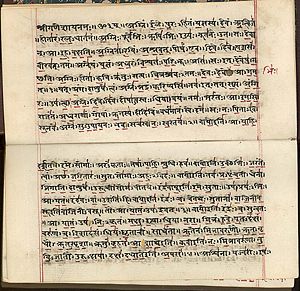Vedas and Saraswati culture
The Vedas are among the oldest sacred texts in the
world dating from c. 1500-500BCE. Most Indologists
agree that an oral tradition existed long before a
literary tradition tentatively may have been set in
(in one shakha, Kanva) from about the 1st century BCE;
however it was again superseded by oral tradition
until c. 1000 CE.[14] Due to the ephemeral nature of
the manuscript material (birch bark or palm leaves),
surviving manuscripts rarely surpass an age of a few
hundred years.[15] The Benares Sanskrit University
has a Rigveda manuscript of the mid-14th century,
however, there are a number of older Veda manuscripts
in Nepal belonging to the Vajasaneyi tradition that
are dated from the 11th century onwards.
The Vedic period lasts for about a millennium,
spanning the Late Bronze Age and the Iron Age.
Gavin Flood[16] sums up mainstream estimates,
according to which the Rigveda was compiled from
as early as 1500 BCE over a period of several centuries.
The Vedic period reaches its peak only after the
composition of the mantra texts, with the
establishment of the various shakhas all over
Northern India which annotated the mantra s
amhitas with Brahmana discussions of their
meaning, and reaches its end in the age of Buddha
and Panini and the rise of the Mahajanapadas
(archaeologically, Northern Black Polished Ware).
Michael Witzel gives a time span of c. 1500 BCE to
c. 500-400 BCE. Witzel makes special reference to
the Mitanni material of ca. 1400 BCE as the only
epigraphic record of Indo-Aryan that may date to
the Rigvedic period. However Mitanni Indo-Aryan
is linguistically slightly older than the language of
the Rigveda, and the comparison thus still does not
allow for an absolute dating of any Vedic text.
He gives 150 BCE (Patanjali) as a terminus ante
quem for all Vedic Sanskrit literature, and 1200
BCE (the early Iron Age) as terminus post quem
for the Atharvaveda







No comments:
Post a Comment